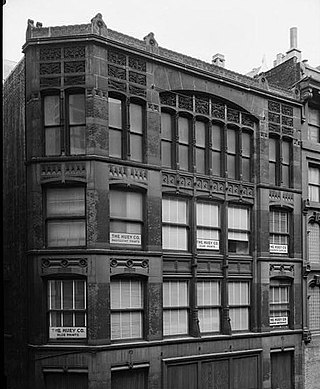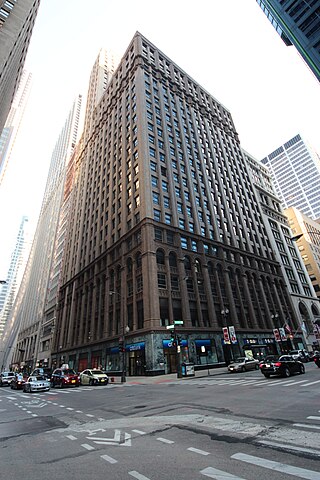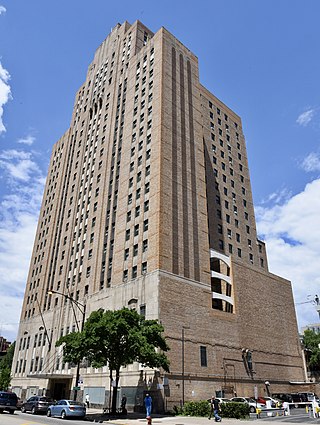
The Magnificent Mile is a section of Michigan Avenue in Chicago devoted to retail, dining, hotels and tourist attractions. Running from the Chicago River to Oak Street in the Near North Side, the district is located one block east of Rush Street and is the main retail corridor between the Loop and Gold Coast. It is bounded by Streeterville neighborhood to its east and River North to its west.

The Reliance Building is a skyscraper located at 1 W. Washington Street in the Loop community area of Chicago, Illinois. The first floor and basement were designed by John Root of the Burnham and Root architectural firm in 1890, with the rest of the building completed by Charles B. Atwood in 1895. It is the first skyscraper to have large plate glass windows make up the majority of its surface area, foreshadowing a design feature that would become dominant in the 20th century.

The Blackstone Hotel is a historic 290-foot (88 m) 21-story hotel on the corner of Michigan Avenue and Balbo Drive in the Michigan Boulevard Historic District in the Loop community area of Chicago, Illinois. Built between 1908 and 1910, it is on the National Register of Historic Places. The Blackstone is famous for hosting celebrity guests, including numerous U.S. presidents, for which it was known as the "Hotel of Presidents" for much of the 20th century, and for contributing the term "smoke-filled room" to political parlance.
This is a list of the 137 National Register of Historic Places listings in Cook County, Illinois outside Chicago and Evanston. Separate lists are provided for the 62 listed properties and historic districts in Evanston and the more than 350 listed properties and districts in in Chicago. The Chicago Sanitary and Ship Canal Historic District extends through the West Side of Chicago, DuPage County and Will County to Lockport.
There are more than 350 places listed on the United States National Register of Historic Places in Chicago, Illinois, including 83 historic districts that may include numerous historic buildings, structures, objects and sites. This total is documented in the tables referenced below. Tables of these listings may be found in the following articles:

The Arc at Old Colony is a 17-story landmark building in the Chicago Loop community area of Chicago, Illinois. Designed by the architectural firm Holabird & Roche in 1893–94, it stands at approximately 215 feet and was the tallest building in Chicago at the time it was built. The building was designated a Chicago Landmark on July 7, 1978. It was the first tall building to use a system of internal portal arches as a means of bracing the structure against high winds.

The Old Chicago Water Tower District is a historic district along the Magnificent Mile shopping district in the Near North Side community area of Chicago, Illinois. The district is located on both sides of North Michigan Avenue between East Chicago and East Pearson Streets. It includes the Chicago Water Tower, Chicago Avenue Pumping Station, and Chicago Fire Department Fire Station No. 98. All three structures are part of the Chicago Landmark district designated on October 6, 1971. The Water Tower and Pumping Station were jointly added to the National Register of Historic Places on April 23, 1975. In addition the Tower was named an American Water Landmark in 1969. The Water Tower was also one of the few buildings to survive the Great Chicago Fire. The district is the namesake of the nearby Water Tower Place.

The Black Metropolis–Bronzeville District is a historic African-American district in the Bronzeville neighborhood of the Douglas community area on the South Side of Chicago, Illinois.

The Jewelers Building at 15–17 Wabash Avenue between East Monroe and East Madison Streets in the Loop community area of Chicago in Cook County, Illinois, United States was built in 1881/82 and was designed by Dankmar Adler and Louis Sullivan. It is the only example of the early work of Adler & Sullivan that survives in the Loop. It is also known as the Iwan Ries Building, and the "Little" Jewelers Building to distinguish from the larger structure at 35 East Wacker Drive, which was built in 1925–27.

Loop Retail Historic District is a shopping district within the Chicago Loop community area in Cook County, Illinois, United States. It is bounded by Lake Street to the north, Ida B. Wells Drive to the south, State Street to the west and Wabash Avenue to the east. The district has the highest density of National Historic Landmark, National Register of Historic Places and Chicago Landmark designated buildings in Chicago. It hosts several historic buildings including former department store flagship locations Marshall Field and Company Building, and the Sullivan Center. It was added to the National Register of Historic Places on November 27, 1998. It includes 74 contributing buildings and structures, including 13 separately listed Registered Historic Places, and 22 non-contributing buildings. Other significant buildings in the district include the Joffrey Tower, Chicago Theatre, Palmer House, and Page Brothers Building. It also hosts DePaul University's College of Commerce, which includes the Kellstadt Graduate School of Business and the Robert Morris College.

11 South LaSalle Street Building or Eleven South LaSalle Street Building is a Chicago Landmark building that is listed on the National Register of Historic Places and that is located at 11 South LaSalle Street in the Loop community area of Chicago, Illinois, United States. This address is located on the southeast corner of LaSalle and Madison Street in Cook County, Illinois, across the Madison Street from the One North LaSalle Building. The building sits on a site of a former Roanoke building that once served as a National Weather Service Weather Forecast official climate site and replaced Major Block 1 after the Great Chicago Fire. The current building has incorporated the frontage of other buildings east of the original site of Major Block 1.

The Silversmith Hotel is a boutique hotel located in downtown Chicago, Illinois. It occupies the historic Silversmith Building, designed in 1896 by Peter J. Weber of the architectural firm of D.H. Burnham and Company, who also designed the Fisher Building. The building's architecture reflects the transition from Romanesque Revival architecture to Chicago school architecture. The Silversmith Building was listed on the National Register of Historic Places in 1997.
Currently there are 124 properties listed on the National Register of Historic Places in Central Chicago, out of more than 350 listings in the City of Chicago. Central Chicago includes 3 of the 77 well-defined community areas of Chicago: the historic business and cultural center of Chicago known as the Loop, as well as the Near North Side and the Near South Side. The combined area is bounded by Lake Michigan on the east, the Chicago River on the west, North Avenue on the north, and 26th Street on the south. This area runs 5.25 miles (8.45 km) from north to south and about 1.5 miles (2.4 km) from east to west.

The Peoples Gas Building at 122 South Michigan Avenue on the corner of Adams Street in the Loop community area of Chicago, Illinois.

The Fort Dearborn Hotel is a skyscraper and former hotel located at 401 S. Lasalle St. in the Loop community area of Chicago, Illinois. The 17-story hotel was designed by Holabird & Roche and finished in 1914. Designed in the Venetian Renaissance style, the hotel was built with gray and reddish brown brick and featured terra cotta ornamentation. The lobby features two murals by local artist Edgar Cameron depicting scenes of Fort Dearborn. The hotel was built to serve businessmen during a period of extensive hotel construction in Chicago; its site was chosen for its access to transportation, as it was located near LaSalle Street Station and the LaSalle/Van Buren 'L' station. The Hotel Sherman Co. owned both the Fort Dearborn Hotel and the nearby Hotel Sherman, and the two hotels had a common management and kitchen staff. However, while the Hotel Sherman was a typical luxury hotel of the era, the Fort Dearborn Hotel focused on providing practical amenities at lower rates and set an example as a "popular, commercial hotel". The hotel is now an office building known as the LaSalle Atrium Building.

The East Rockford Historic District is a historic commercial area of Rockford, Illinois, United States.

The Victor F. Lawson House is a historic former YMCA building located at 30 W. Chicago Avenue in the Near North Side neighborhood of Chicago, Illinois. The building was built in 1931 for the YMCA of Metropolitan Chicago, which was established in 1858 and had grown considerably during the 1920s. It was named for newspaperman Victor Lawson, one of the YMCA's largest donors until his death in 1925. The architecture firm of Perkins, Chatten & Hammond designed the 24-story building in the Art Deco style. The YMCA used the new building to provide affordable housing and community services during the Great Depression, including family programs that were copied in other cities, and the building became the headquarters of the YMCA of Metropolitan Chicago after World War II.

The Union Park Hotel is a historic hotel building located at 1519-1521 W. Warren Boulevard in Chicago, Illinois. The building was built in 1929-30 as an apartment hotel, a common type of housing for Chicago laborers in the 1920s. The hotel's Art Deco design reflects the national popularity of the style in the 1920s. The building's piers give it a vertical emphasis common to Art Deco works, and its decorative elements reflect the style's geometric focus. The colorful brick and terra cotta facade of the building is also characteristic of Art Deco buildings of the late 1920s, though color is seldom used extensively in Chicago's other Art Deco buildings.



















